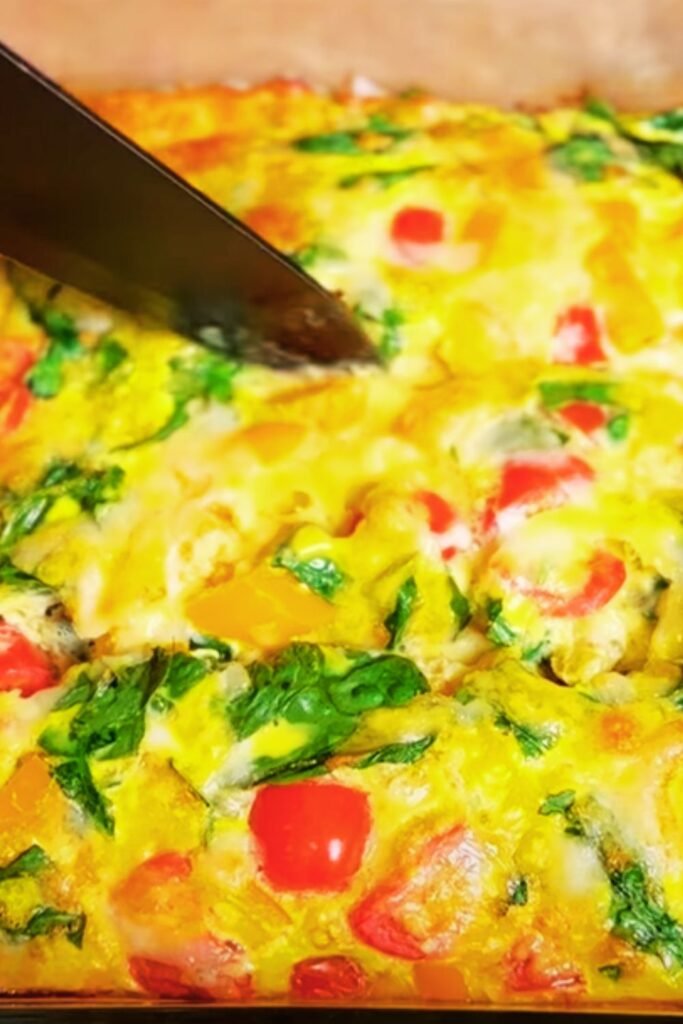There’s something magical about waking up to the aroma of a delicious breakfast casserole baking in the oven. As someone who values both flavor and nutrition in my morning meals, I’ve perfected this Spinach Florentine Breakfast Casserole over years of weekend brunches and holiday gatherings. This make-ahead wonder combines the classic flavors of Florentine cuisine with the convenience of a modern breakfast dish, creating something that’s both elegant and comforting.
What I love most about this recipe is its versatility. I can prepare it the night before for stress-free entertaining, or whip it up on a lazy Sunday morning when I have a bit more time to myself. The combination of tender spinach, melty cheese, fluffy eggs, and savory herbs creates layers of flavor that elevate this far beyond ordinary breakfast fare.
Whether you’re hosting a brunch for friends, planning a special family breakfast, or simply meal prepping for your week ahead, this Spinach Florentine Breakfast Casserole deserves a spot in your recipe collection. Let me walk you through how to create this crowd-pleasing dish that beautifully balances nutrition and indulgence.
What Makes This Casserole “Florentine”?
Before diving into the recipe, I should explain the “Florentine” in our casserole’s name. In culinary terms, “Florentine” refers to dishes prepared in the style of Florence, Italy, typically featuring spinach as a key ingredient. The term has evolved in modern cooking to generally indicate any dish prominently featuring spinach.
The tradition dates back to Catherine de Medici, who moved from Florence to France in the 16th century and brought her love of spinach along with her Italian chefs. They prepared so many spinach dishes that eventually anything with spinach became known as “à la Florentine.”
In our breakfast casserole, we honor this tradition by making spinach the star of the show, complemented by other ingredients that enhance its flavor without overshadowing it.
Ingredients You’ll Need
For this recipe, I focus on quality ingredients that work harmoniously together. Here’s what you’ll need to serve 8-10 people:
- 2 tablespoons olive oil
- 1 medium onion, finely diced (about 1 cup)
- 3 cloves garlic, minced
- 16 ounces fresh spinach (or 2 10-ounce packages frozen spinach, thawed and drained)
- 8 large eggs
- 1½ cups whole milk
- ½ cup heavy cream
- 1 teaspoon dried basil
- 1 teaspoon dried oregano
- ½ teaspoon red pepper flakes (optional)
- 1 teaspoon sea salt
- ½ teaspoon freshly ground black pepper
- 2 cups shredded Gruyère cheese (about 8 ounces)
- 1 cup crumbled feta cheese
- 8 slices sourdough bread, cubed (about 6 cups)
- ½ cup sun-dried tomatoes, chopped
- Fresh herbs for garnish (basil, parsley, or chives)
Kitchen Tools You’ll Need

- 9×13-inch baking dish
- Large skillet
- Mixing bowls (large and medium)
- Whisk
- Sharp knife and cutting board
- Measuring cups and spoons
- Cheese grater (if using block cheese)
- Kitchen towel or paper towels (for squeezing spinach if using frozen)
Step-by-Step Instructions
Preparing the Spinach and Aromatics
- Heat olive oil in a large skillet over medium heat until shimmering.
- Add diced onion and sauté for 3-4 minutes until translucent and beginning to soften.
- Add minced garlic and cook for another 30 seconds, until fragrant.
- If using fresh spinach: Add in batches, stirring until wilted. This will take about 3-4 minutes. Once all spinach is wilted, remove from heat and let cool slightly.
- If using frozen spinach: Ensure it’s completely thawed and squeeze out excess moisture using a clean kitchen towel or paper towels. Add to the skillet with onions and garlic, stirring to combine and heat through.
- Transfer the spinach mixture to a plate lined with paper towels to absorb excess moisture.
Preparing the Egg Mixture
- In a large bowl, whisk together eggs, milk, and heavy cream until well combined.
- Add dried basil, oregano, red pepper flakes (if using), salt, and pepper, whisking to incorporate.
- Stir in 1½ cups of shredded Gruyère and ½ cup of crumbled feta, saving the rest for topping.
Assembling the Casserole
- Lightly grease a 9×13-inch baking dish with butter or cooking spray.
- Arrange the cubed sourdough bread evenly across the bottom of the dish.
- Distribute the cooled spinach mixture over the bread.
- Scatter chopped sun-dried tomatoes throughout.
- Pour the egg and cheese mixture evenly over everything, pressing down gently to ensure the bread absorbs the liquid.
- Sprinkle the remaining Gruyère and feta cheeses over the top.
Baking Options
Option 1: Bake Immediately
- Preheat your oven to 350°F (175°C).
- Let the assembled casserole sit for 15-20 minutes at room temperature while the oven preheats, allowing the bread to absorb some of the egg mixture.
- Bake for 45-50 minutes until the center is set and the top is golden brown.
Option 2: Make Ahead
- After assembling, cover the baking dish tightly with plastic wrap.
- Refrigerate for at least 4 hours or overnight (up to 24 hours).
- When ready to bake, remove from refrigerator and let sit at room temperature for 30 minutes.
- Preheat oven to 350°F (175°C).
- Remove plastic wrap and bake for 50-55 minutes until center is set and top is golden brown.
Finishing Touches
- Let the casserole rest for 10 minutes before serving.
- Garnish with fresh herbs of your choice.
- Slice into squares and serve warm.
Nutrition Information
I believe in knowing what goes into my food, so here’s a detailed nutritional breakdown of this casserole (approximate values per serving, based on 10 servings):
| Nutrient | Amount | % Daily Value* |
|---|---|---|
| Calories | 345 | – |
| Total Fat | 22g | 28% |
| Saturated Fat | 11g | 55% |
| Cholesterol | 195mg | 65% |
| Sodium | 680mg | 30% |
| Total Carbohydrate | 18g | 7% |
| Dietary Fiber | 2g | 7% |
| Sugars | 3g | – |
| Protein | 20g | 40% |
| Calcium | 380mg | 29% |
| Iron | 3mg | 17% |
| Potassium | 390mg | 8% |
| Vitamin A | 5000IU | 100% |
| Vitamin C | 15mg | 17% |
| Vitamin D | 1.5mcg | 8% |
| Folate | 185mcg | 46% |
*Percent Daily Values are based on a 2,000 calorie diet.
Why This Recipe Works: The Science Behind It
As someone fascinated by the science of cooking, I love understanding why recipes work. Here’s what makes this casserole so successful:
The Role of Bread
The cubed sourdough serves two crucial purposes:
- Structure: It provides a sturdy base that holds everything together
- Texture: The bread absorbs the egg mixture while still maintaining some chew, preventing the casserole from becoming too dense
The slight tang of sourdough also counterbalances the richness of the eggs and cheese, adding complexity to the flavor profile.
The Spinach Treatment
Removing excess moisture from spinach is crucial because:
- It prevents the casserole from becoming watery
- It concentrates the spinach flavor
- It allows better integration with other ingredients
Fresh spinach contains about 90% water by weight, which is why it reduces so dramatically when cooked.
The Cheese Blend
I carefully selected two complementary cheeses:
- Gruyère: Provides excellent meltability with a complex, nutty flavor that pairs perfectly with eggs
- Feta: Adds bright, tangy notes and a salty punch that enhances the overall taste while maintaining its texture
Variations to Try

One of the joys of cooking is making recipes your own. Here are some variations I’ve tried and loved:
Mediterranean Twist
- Add ½ cup of chopped Kalamata olives
- Replace feta with goat cheese
- Include 1 tablespoon of fresh lemon zest
- Use Greek-style yogurt instead of heavy cream
Hearty Meat Option
- Add 1 cup of cooked, crumbled breakfast sausage or bacon
- Use smoked gouda instead of Gruyère
- Add 1 teaspoon of smoked paprika to the egg mixture
- Include ½ cup sautéed bell peppers with the onions
Vegetable Garden Version
- Add 1 cup of sautéed mushrooms
- Include ½ cup each of diced red bell pepper and zucchini
- Replace the bread with partially cooked shredded potatoes
- Use fresh thyme and rosemary instead of dried herbs
Dairy-Free Adaptation
- Use unsweetened almond milk in place of whole milk
- Replace heavy cream with full-fat coconut milk
- Use your favorite dairy-free cheese substitutes
- Add an extra egg for more structure
Troubleshooting Common Issues
Even experienced cooks encounter challenges. Here are solutions to common problems:
Soggy Center
Cause: Too much moisture in ingredients or insufficient baking time.
Solutions:
- Ensure spinach is thoroughly drained
- Slightly toast bread cubes before assembling
- Increase baking time by 5-10 minutes
- Let casserole rest longer before serving
Too Dry
Cause: Overbaking or too much bread.
Solutions:
- Reduce baking time by 5 minutes
- Increase the egg mixture by adding 2 more eggs and ¼ cup more milk
- Cover with foil for the first 30 minutes of baking
Uneven Cooking
Cause: Oven hot spots or uneven ingredient distribution.
Solutions:
- Rotate the dish halfway through baking
- Ensure ingredients are evenly distributed before pouring egg mixture
- Use an oven thermometer to verify temperature accuracy
Serving Suggestions

While this casserole stands beautifully on its own, I love pairing it with complementary dishes to create a memorable meal:
For Breakfast or Brunch
- Fresh fruit salad with seasonal berries and mint
- Crispy hash browns or roasted breakfast potatoes
- Lightly dressed mixed greens
- Freshly squeezed orange juice or grapefruit juice
- Coffee or tea bar with various options
For Lunch or Dinner
- Simple tomato soup
- Crusty artisan bread with herb-infused olive oil
- Roasted vegetable medley
- Light citrus salad with champagne vinaigrette
- Sparkling water with cucumber and lemon
Make-Ahead and Storage Tips
This casserole is ideal for meal prep and entertaining. Here’s how I manage it:
Make-Ahead Options
- Fully Assembled, Unbaked: Prepare as directed, cover tightly, and refrigerate for up to 24 hours before baking.
- Partially Prepped: Prepare the spinach mixture and egg mixture separately up to 2 days ahead, then assemble and bake when needed.
- Components: Cube bread and let dry out at room temperature for a day; shred cheese and store in an airtight container; prepare spinach mixture and refrigerate separately.
Storage Instructions
- Refrigeration: Leftover baked casserole can be covered and refrigerated for up to 4 days.
- Freezing Unbaked: Assemble, cover tightly with plastic wrap and aluminum foil, and freeze for up to 2 months. Thaw overnight in refrigerator before baking.
- Freezing Baked: Cool completely, cut into portions, wrap individually, and freeze for up to 2 months.
Reheating Guidelines
- From Refrigerated: Cover with foil and reheat in a 325°F oven for 15-20 minutes or until heated through.
- From Frozen (previously baked): Thaw overnight in refrigerator, then reheat covered at 325°F for 20-25 minutes.
- Microwave: Individual portions can be microwaved for 1-2 minutes, though texture will be slightly different than oven reheating.
Equipment Alternatives
Don’t have exactly the right equipment? Here are some workarounds:
- No 9×13 Dish: Use two 8×8-inch dishes, dividing ingredients equally (reduce baking time by about 5-7 minutes).
- No Large Skillet: Wilt spinach in batches in a smaller pan, or blanch briefly in boiling water, then drain well.
- No Whisk: Use a fork to beat eggs until well blended.
Why I Love This Recipe
This Spinach Florentine Breakfast Casserole has become a staple in my kitchen for so many reasons. Beyond its incredible flavor, it’s given me confidence in entertaining, providing a reliable centerpiece that lets me focus on enjoying my guests rather than last-minute cooking.
I’ve found that it’s the perfect recipe to introduce more vegetables into breakfast routines, especially for those who might be hesitant about spinach. The combination of cheeses and herbs transforms the spinach into something irresistible, and I’ve watched many a skeptic become a convert after trying this dish.
What I cherish most, though, are the gatherings this casserole has complemented—lazy weekend mornings with family, holiday brunches with friends, and even simple self-care Sundays when I prepare it just for myself, enjoying leftovers throughout the week. Food has a way of creating memories, and this dish has certainly created many wonderful ones in my home.
Questions & Answers About This Recipe
Can I use baby spinach instead of regular spinach? Absolutely! Baby spinach works wonderfully in this recipe and often requires less prep as the stems are more tender. You’ll need the same amount by weight, and it will typically wilt faster than mature spinach.
Is there a substitute for Gruyère cheese if I can’t find it? Yes, Swiss cheese makes an excellent substitute as it has a similar nutty flavor and melting properties. Emmental, Jarlsberg, or even a good quality white cheddar would also work well in this recipe.
Can I make this casserole gluten-free? Definitely! Simply substitute your favorite gluten-free bread for the sourdough. I recommend toasting the gluten-free bread cubes slightly before adding them to the casserole to help with texture and absorption.
How can I tell when the casserole is done baking? The casserole is done when the center is set (not jiggly) and the top is golden brown. You can also insert a knife into the center—it should come out clean or with just a few moist crumbs attached. An instant-read thermometer should register at least 160°F in the center.
Can I add more vegetables to this recipe? Absolutely! This recipe is very forgiving. Just make sure any additional vegetables are properly cooked and drained of excess moisture before adding. Sautéed mushrooms, bell peppers, asparagus, and artichoke hearts all make wonderful additions.
What’s the best way to reheat individual portions? For the best texture, reheat individual portions in a 325°F oven for about 10 minutes. If you’re in a hurry, the microwave works too—heat on 70% power for 1-2 minutes, covering the portion with a damp paper towel to prevent it from drying out.
Can I use milk alternatives like almond or oat milk? Yes, unsweetened almond milk or oat milk work well as substitutes for dairy milk. The casserole may be slightly less rich, but the flavor will still be excellent. You might want to add an extra egg to help with binding if using plant-based milks.
My family doesn’t like sun-dried tomatoes. What can I use instead? Fresh cherry tomatoes (halved), roasted red peppers, or even sautéed mushrooms make great substitutes for sun-dried tomatoes. You’re looking for something that adds a pop of flavor and a different texture.
Can I prepare this in a slow cooker? While not ideal, you can adapt this for a slow cooker. Layer ingredients as directed, cook on low for 3-4 hours or until eggs are set. The texture will be softer, and you won’t get the golden brown top, but the flavor will still be there.
How far in advance can I assemble this casserole? This casserole can be fully assembled and refrigerated up to 24 hours before baking. Any longer than that, and the bread may become too soggy. For longer prep ahead, I recommend preparing the components separately and assembling closer to baking time.
Final Thoughts
Creating a truly exceptional breakfast casserole is about balancing convenience with quality, nutrition with indulgence. This Spinach Florentine Breakfast Casserole achieves that balance beautifully, offering a make-ahead solution that doesn’t compromise on flavor or presentation.
I hope this recipe finds its way into your regular rotation, perhaps becoming a tradition for special breakfasts or a reliable solution for busy weeks. There’s something deeply satisfying about sharing a homemade dish that nourishes both body and soul, bringing people together around the table to start the day with something special.
Remember that cooking is as much about the process as the result. Take pleasure in each step—the sizzle of onions hitting the pan, the vibrant green of fresh spinach, the aroma of herbs and cheese melding in the oven. These sensory experiences are what make cooking such a joyful part of our lives.
So preheat that oven, gather your ingredients, and enjoy creating a breakfast masterpiece that’s sure to impress even the most discerning breakfast enthusiasts in your life.